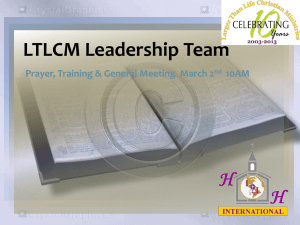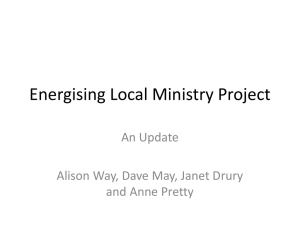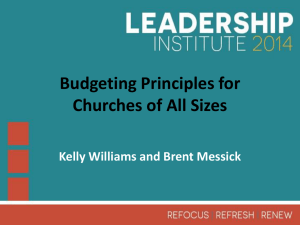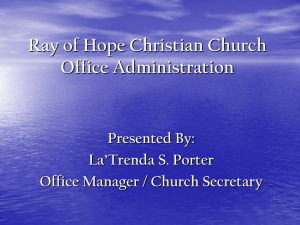Who Are We Now? - Transitional Ministry
advertisement
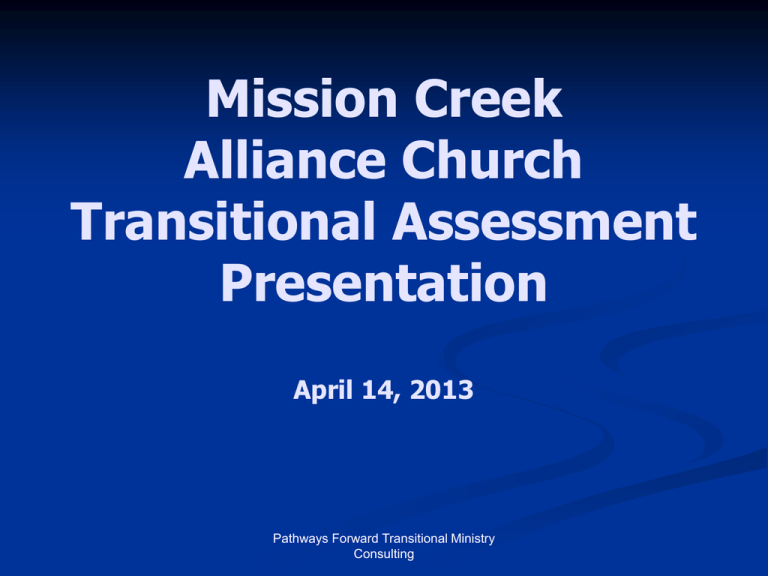
Mission Creek Alliance Church Transitional Assessment Presentation April 14, 2013 Pathways Forward Transitional Ministry Consulting Proposed Agenda Assessment Presentation for the Congregation Welcome and Opening Prayer A Brief History of Mission Creek Alliance (Assessment Part 1) Presentation of Assessment Part 2 Short Q & A – clarification questions Coffee Break Presentation of Survey Results Presentation of the KRAs Opportunity for Q & A Prayer Time & Close What will be presented tonight . . . Part I - A Brief History of Mission Creek Alliance - addresses “Who were we?” Part II – Assessment Research “Who were we?” “Who are we now?” and “What is our context?” Part III – Church Health Survey Results Part IV - Presentation of Key Result Areas Transition - The Big Idea Seasons of transition can be windows of opportunity for churches to experience spiritual renewal, increased health, focused vision and renewed mission prior to engaging in the pastoral search. Major Goals for Churches in Transition To help churches thrive through transition by providing leadership, resources and support. (Ministry Track) To help churches engage a Lead Pastor from a posture of health with clarity of vision and mission. (Transitional Track) The Ultimate Objective To welcome a new Lead Pastor . . . . to a healthy church that is growing in renewal - spiritually, relationally, organizationally and operationally. who has been hired through a thoughtful, collaborative search process in dependence on the Holy Spirit’s guidance. Major Phases of Transition • Healthy closure with the past • Regaining Stability • Assessment of Church Health • Developing a Transitional Plan • Preparing for the Pastoral Search • Conducting the Pastoral Search • Hiring a Lead Pastor • Evaluation of the process Key Questions of Transition Today: Who were we? Who are we now? What is our context? (internal/external) Key Questions of Transition Future questions to be answered prior to search: How do we engage our community? Who do we hope to become? (Mission and Vision) What kind of leader or leaders do we need? The answers to these six questions become the major content for the Pastoral Search Profile. Intent and Limitations . . . Not intended to be a 3600 ministry review An assessment for the purposes of the Transitional process Identifies both strengths and Key Result Areas to be addressed Assessment Objectives To present a realistic picture of MCA. To explore how this information affects us. To encourage prayer for wisdom and guidance. Before we begin . . . We are starting from different places today. We will need to check our emotions at the door. History handout provided – please make notes. We recognize that God is in all of this. We will need to check our emotions at the door. Mission Creek Alliance Church Transitional Assessment Part I A Brief History of Mission Creek Alliance Church Mission Creek Alliance Church Transitional Assessment Part II Who Were We? Who Are We Now? What is our Context? Who Were We? Some Statistics Attendance 1960 – 2012 700 Peak Attendance - 642 in 1986 * 600 500 375 400 300 200 100 42 1960 1970 1980 1990 2000 2010 1266 Recorded Conversions 1962 – 2008 100 90 80 70 60 50 40 30 20 10 0 1962 1981 1995 Records were not available for every year 2008 644 Recorded Baptisms 1960 - 2012 45 40 35 30 25 20 15 10 5 1960 1970 1980 1990 2000 2010 General Fund Giving 1962 - 2012 $700,000 $600,000 $500,000 $400,000 $300,000 $200,000 $100,000 1960 1970 1980 1990 2000 2010 * 6 month fiscal year Missions Fund Giving 1963 - 2012 $190,000 $160,000 $120,000 $100,000 $80,000 $60,000 $40,000 $20,000 1960 1970 1980 1990 2000 2010 Percentage of Missions Giving from Total Giving 50% 40% 30% 20% 10% Indebtedness Patterns 1961 - Present $1,400,000 Gordon Drive Property - 1994 $1,200,000 $1,000,000 $322,000 $800,000 $600,000 $400,000 $200,000 $0 1960 1970 1980 1990 2000 2010 Personnel 1962 – Present Full Time Pastoral Staff - 41 Senior Pastors – 7 Associate/Assistant – 8 Children’s – 6 Youth – 7 Worship/Music – 6 Seniors/Care – 4 Executive/Administration - 3 Interim/Transitional Pastors – 4 Interns ~ 7 plus Missionary in Residence - 2 Part Time Ministry Staff – 10 Administrative & Support Staff – 7 Custodial Staff - 13 Total Number of Elders who have served – 87 Who Were We? Slogans & Mission/Vision Statements 1960 – The Fourfold Gospel 1962 - My meat is to do the will of him who sent me and to finish his work 1967 – A Year of Evangelism (National Office) 1979 – To Glorify God through Evangelism and Edification Who Were We? Slogans & Mission/Vision Statements 1988 – Discovering God’s love and Sharing God’s love 1990 - Reproducing faithful followers of Christ (& 1993) in our community and our world 1992 - Celebrating God's presence, Communicating God's message, Demonstrating God's love, Educating God's people Who Were We? Slogans & Mission/Vision Statements 1997 – The blunt edge of the wedge 1998 - The fine edge of the wedge 1999 – Large church amenity with a medium church feel 1999 – SAGE: stewardship, assimilation, gifts, evangelism Who Were We? Slogans & Mission/Vision Statements 2000’s A number of “we dream of the day” statements 2004 – Deeper – Wider theme 2008 - An intergenerational community going deeper and wider with God Who Were We? - Positives What we learned from over 60 long term attenders 1960’s: assorted fellowship events, Sunday school focus, church facility built, growth 1970’s: new church building, revival meetings, Sunday school ministry (buses) hippie group, anticipation in transition, Springfield facility, strong youth ministry and youth involvement in church, camps 1980’s: strong youth ministry, outreach events, missions conferences, care groups, musical events, strong programs, fellowship, women’s ministry 1990’s: youth ministry, music including children’s choir, strong preaching, care groups/fellowship 2000’s: stable leadership, youth, kids day camp, church renovation, many strong ministries Who Were We? - Challenges What we learned from over 60 long term attenders 1960’s: no air conditioning, difficult pastoral transitions, financial and facilities issues 1970’s: property and facilities issues, more pastoral transitions 1980’s: tensions over music, a lawsuit, lack of space, pastoral transitions 1990’s: difficult pastoral transitions/turnover, dissension and an exodus of people, music tensions, property purchase 2000’s: adult Sunday school dropped, renovations/meeting in rental, Westside partnership, a long transition, assorted leadership issues, music issues, a recent exodus Who Are We Now? Average attendance 2012 Total number of ministries Total volunteer positions filled Total number of volunteers Attendance/Volunteerism rate 375 27 305 188 50% Who Are We Now? – Staffing Pastoral Staff 3 Full Time Pastoral Staff 1 Part Time Ministry Director Support Staff 2 Full Time Admin Staff 1 Part Time Admin Staff 1 Full Time Facility Staff Who Are We Now? Annual Basic Operating Costs 2007 2008 2009 2010 2011 2012 $140,000 $138,000 $165,000 $ 84,000 $140,000 $120,000 (6 month fiscal year) What is our Context? Some data about the City of Kelowna and Comparisons with Mission Creek Alliance 2011 Kelowna Demographics by Age 6% 8% 80+ 10% 0-9 11% 70-79 10-19 11% 60-69 20-29 15% 50-59 40-49 14% 30-39 11% 14% 2012 MCA Demographics by Age 14% 18% 80+ 0-9 10-19 16% 70-79 10% 7% 20-29 30-39 60-69 10% 50-59 11% 40-49 5% 10% Demographic Comparisons by % 18 MCA Kelowna 16 14 12 10 8 6 4 2 0 0-9 10-19 20-29 30-39 40-49 50-59 60-69 70-79 80+ Population Growth Projections 2011 2016 2021 2026 City 117,312 130,750 141,689 161,701 Region 178,839 10.9% since 2006 198,800 215,719 238,314 Estimated projected growth rate is 1.5% to 2030 Other Demographic Data - Kelowna Male - 48% Female - 52% 56,310 61,003 Median age Canada British Columbia Kelowna 40.6 41.9 43.0 Kelowna Statistics - Education Kelowna Grade 12 or less 20% High School Diploma 30% Trade Certificate 13% Diploma 24% University degree 37% BC Avg. 20% 28% 11% 22% 41% Personal Income Ranges – Kelowna Under $15,000 $15,000 – 24,999 $25,000 - 34,999 $35,000 - 44,999 $45,000 - 54,999 $60,000 and over Kelowna 29% 20% 16% 11% 10% 13% BC Avg. 33% 17% 13% 11% 10% 15% Average household income $67,000 (2010) Kelowna Families Total number of families 32,825 Married Common law Single parent 23,255 4,515 5,055 71% 14% 15% 40% of families have children living at home (age 24 or younger) 13% of all families are blended Immigration Trends - Kelowna • 7% of growth is from other places in Canada • One of the “whitest” cities in BC • 6.2% visible minorities (24% BC, 16% Canada) • 65% of immigration is European/Caucasian • Growing immigration trends – Asian Who we are now? Canadian context % of Canadians who attend church weekly 1985 2005 age 15 to 24 23% 16% age 25 to 44 25% 16% age 45 to 64 39% 22% age 65 over 42% 39% British Columbia figures tend to be lower. * Provided by the Evangelical Fellowship of Canada 2009 Who we are now? Canadian context % of population that is Evangelical By attendance 4% By membership 5% By affiliation 11% * Provided by the Evangelical Fellowship of Canada 2009 Who Were We? – Observations • overall, an amazing story of growth and ministry • ongoing emphasis on ministry to children, youth • missions sending church – generous giving to missions • accustomed to strong pastoral leadership • a pattern of long term pastors with challenges in between • strong identity with facilities – 3 longest pastorates Who Were We? – Observations • desirous of and challenged by intergenerational model • three major identity phases - developing, large, medium • financially hardy • a sending church – many sent into ministry • many iterations of vision/mission directives • unclear of direction in recent years Mission Creek Alliance Church Transitional Assessment Clarification Q & A Time Mission Creek Alliance Church Transitional Assessment Part III Basic Level of Church Health Survey a “real time” snapshot Survey completed February 19, 2012 Who Participated? Official Member 65% Regular Attender 35% • 103 surveys completed • 54 by ministry leaders • 49 by congregants Age Groups of Participants 30 25 20 15 10 5 0 Teen 20s 30s 40s 50s 60s 70s 80s or older Church Background of Respondants 5% 10% Grew up at MCA Came to MCA from another church 85% Came to MCA with no church background Length of Attendance 30 25 20 15 10 5 0 1 year plus 2-4 5 - 10 10 - 20 20 - 30 30 Sunday Services are meaningful and relevant in the lives of people in our congregation Strongly disagree Mildly disagree Agree Strongly agree “Sunday Services meaningful and relevant” Comments Summary (40) • • • • preaching ministry is effective and relevant music ministry improving but still has a ways to go a sense of stability in recent months desire for testimonies and ministry reports in services We have an effective strategy to impact our community for Christ 60 50 40 30 20 10 0 Strongly disagree Mildly disagree Agree Strongly agree “Impact our community for Christ” Comments Summary (53) • • • • • We have been more effective in the past Current hurts and need for healing hinders this Kids Day Camp identified often A longing to see outreach ministry return We could do more as individuals We have a strong sense of connection with one another in our church family 50 40 30 20 10 0 Strongly disagree Mildly disagree Agree Strongly agree “Strong sense of connection with one another” Comments Summary (47) • • • • • improving in recent months a longing for more fellowship events care group ministry is effective some feel like they are on the outside we could go deeper than Sundays Spiritual Growth of believers is intentional and effective 60 50 40 30 20 10 0 Strongly disagree Mildly disagree Agree Strongly agree Spiritual Growth intentional and effective Comments Summary (32) • • • • • • hard to gauge at this time in certain ministries – kids, women’s, men’s more emphasis needed on small groups for this pulpit ministry is effective to address this concern for helping new/younger believers an area that can grow at MCA As a church community we are being trained and equipped for ministry and service 50 40 30 20 10 0 Strongly disagree Mildly disagree Agree Strongly agree “Trained and equipped for ministry” Comments Summary (33) • • • • this area is struggling due to internal struggles happening through pulpit ministries kids ministry is doing this well many expressed a desire for more Our church has a clear vision of its unique purpose and mission in our community 60 50 40 30 20 10 0 Strongly disagree Mildly disagree Agree Strongly agree “Clear vision of purpose and mission” Comments Summary (34) • • • • • a clear sense that this is lacking anticipation to seek God’s direction desire for greater communication about this at a standstill since Leon left Sidetracked due to internal struggles Our church has an effective structure that is organized to help us accomplish our mission 50 40 30 20 10 0 Strongly disagree Mildly disagree Agree Strongly agree “Effective structure” Comments Summary (33) • this area is a mystery to most congregants • at the start of a rebuilding process Our church develops plans that enable positive movement towards clear goals and objectives. 25 20 15 10 5 0 Strongly disagree Mildly disagree Agree Strongly agree “Develops Clear Plans” Comments Summary (39) • • • • if plans are in place most don’t know about them at the start of a transition plan – positive do we have an effective planning process? greater healing will help in this area Our church provides many opportunities to be involved in ministry 80 60 40 20 0 Strongly disagree Mildly disagree Agree Strongly agree Opportunities to be involved Comments Summary (24) • overwhelming sense of opportunities • could use help knowing how to engage • most opportunities for internal ministries Our church has an effective prayer emphasis that positively impacts our ministry 60 50 40 30 20 10 0 Strongly disagree Mildly disagree Agree Strongly agree “Prayer Emphasis” Comments Summary (26) • • • • an overall sense that this is healthy a ministry that can always grow prayer chain and pre-service meaningful continue to encourage this aspect of church life Our facilities are adequate to meet our current and future ministry needs 50 40 30 20 10 0 Strongly disagree Mildly disagree Agree Strongly agree Facilities Adequate Comments Summary (18) • • • • strong sense that facilities are adequate some long term planning for facility care important facilities could be used more great for potential future ministry Addressing Change Survey Results Categories: • • • • • • • Leadership Traditions Experience with implementing change Risk Taking Dealing with conflict Motivation Readiness we have a solid leadership core that is ready for change Leadership 16% 49% some leaders are ready, others are not we have few leaders ready for change 35% Traditions 22% 28% 50% people are not tightly bound by traditions here we have a few sacred traditions but not held by all several traditions are widely held and not easily changed Experienced with change 33% 50% 17% we have key people who have helped bring about change in the past we have key people who initiate change in the workplace but not in the church we have few people with experience in the change process Risk Taking 11% our church affirms risk takers and change agents 28% 61% our church tolerates (puts up with) risk takers and change agents our church discourages risk taking and change agents Dealing with Conflict 25 Congregation Leadership 20 15 10 5 Healthy and Constructive Minor Conflict Process OK Unhealthy Process Motivation for Change Congregation Leadership 18 14 14 13 10 8 Core leaders have a sense of urgency A few people are motivated but not all We have a cautious status quo culture Organizational Structure Congregation Leadership 26 15 14 11 11 9 We have been developing new more effective ways Some changes but it has been “hit and miss” No significant changes made Readiness for Change Congregation Leadership 21 16 16 13 11 Readiness for change amongst the core Change possible but will need case by case explanation 10 Resistance to change will need to be addressed Who Are We Now? Observations Coming through a season of loss and confusion Weary of extended conflict and struggle Regrouping and recovering stability Committed to let God rebuild and renew Committed to prayer, healing Who Are We Now? Observations Wondering about the future – mission Multiplicity of expectations Diverse intergenerationally Longing for a new season of effective ministry – people want to be part of this Key Result Areas (KRAs) Areas to address with the Board of Elders What must be addressed prior to search? What should be addressed during the search and beyond? What should be addressed with the new Senior Pastor? KRA #1 – Governance A review and revision of the governance model and practice at MCA. This includes . . . A clear understanding of the Senior Pastor’s role and relationship with the Board of Elders based on the CMA Local Church Constitution. Establishing healthy, consistent patterns of communication with the staff and church KRA#2: Eldership Clarification, documentation, implementation, and communication of a healthy balanced role of Elders as members of a Governing Board and as “Shepherds of the Flock.” KRA #3: Mission and Vision A complete re-visioning process to help MCA understand its unique sense of purpose and mission in the community at this time in its history. This includes coming to a clear understanding of the meaning of “intergenerational” and deciding if this is still part of the ongoing vision. KRA #4: Vision Stewardship A commitment to become a church where vision is understood to reside in the body and is stewarded by the Board of Elders, versus being solely the responsibility of the Senior Pastor. KRA #5: Conflict Establishing a clear process for dealing with conflict. This includes . . . Reflection on the history of the church to identify Strengths, weaknesses and patterns about how conflict has been handled in the past. Teaching on conflict at the board, ministry leadership and congregational levels. KRA #6: Core Ministries Identifying and focusing on the core ministries of the church through the season of transition. This includes drafting a staffing plan through to June of 2014 Next Steps . . . . • Response to this presentation by congregation • Establish what KRA’s are pre, during, post search • Develop a strategic plan to address KRAs • Develop a ministry strategy for the transition period and beyond Next Steps . . . . • Communicate regularly on progress • Continue with prayer and spiritual formation throughout transition process • Establish benchmarks with Board as to when the church is healthy/ready to move into an active pastoral search process Mission Creek Alliance Church Transitional Assessment Q & A Time
